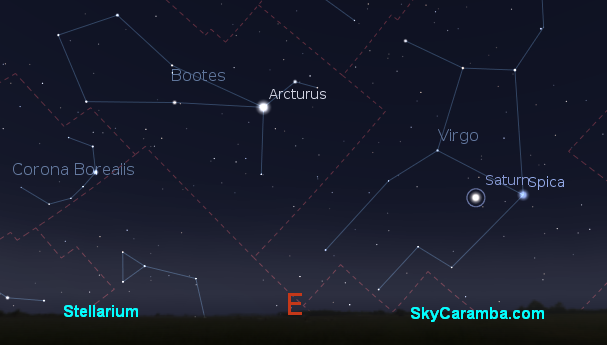SkyCaramba weekly astronomy blog for the week ending April 7, 2012
Saturn’s at opposition this month. That means it’s up all night and Earth is about as close to Saturn as it gets for about another year. The best view you’ll get of the ringed planet in your telescope will be at opposition.
It’s called opposition because the planet is at a place in the sky opposite the sun. It’s easy to visualize Earth between the sun and Saturn. Of course, Saturn is much farther away from Earth and the sun. Saturn will be 8.7 Earth-sun distances (astronomical units) from us.
The best known feature of Saturn is its rings. When Galileo saw Saturn in a telescope, he described it as having ears. He couldn’t see the planet very well with the blurry optics of his time. But as the centuries went by, views became clearer. Astronomers first saw what looked like a solid belt around the planet. Cassini was the first to describe what appeared to be a dark line separating two belts. That’s known as the Cassini division.
Scientists weren’t sure yet if the rings were solid belts or made of numerous chunks of rock orbiting the planet. They’re sure today about the many small rocks but they’re not sure if they’re broken up moons that once orbited Saturn or are rock chunks that never came together as a moon.
Earth and Saturn orbit the sun at different angles. That gives us slowly but dramatically changing perspectives on the planet. Sometimes, we’re looking at Saturn edge-on and the rings practically disappear. That will happen in 2025. Other times, Saturn is tilted toward us so much, we get a somewhat broad view of the rings. The next time we’ll get a broad view of the rings will be in 2017 and 2018. One pole of the planet will be hidden from the rings.
There are 62 natural satellites orbiting Saturn. The largest is Titan and it’s the second largest moon in the solar system. Titan’s bigger than Mercury. It has an atmosphere that’s 95% nitrogen. Saturn appears to have a muddy terrain with sand dunes. The sand could actually be water ice crystals. Winds on Titan are caused by Saturn’s gravity tugging on the moon’s atmosphere. Titan’s the moon you’re most able to see in a telescope.
You can also try to spot Saturn’s second largest moon, Rhea. It’s airless and cratered like Earth’s moon. Slightly unlike Earth’s moon, Rhea has a few hints of color.
Saturn’s the only planet less dense than water. It would float in a pool if you could find a big enough pool to put it in!
The Romans worshiped the god Saturn who oversaw agriculture. The day Saturday is named after him.
Opposition time will be April 15 at 18:22 UT. You can see Saturn rising just after sunset in Virgo. It’s close to the star Spica. The full moon will pass near them on April 6. Enjoy the view. ¡SkyCaramba!
Links:
http://nineplanets.org/saturn.html
http://www.solarviews.com/eng/titan.htm
http://www.solarviews.com/eng/rhea.htm
http://www.nasa.gov/mission_pages/cassini/media/cassini-072104.html
